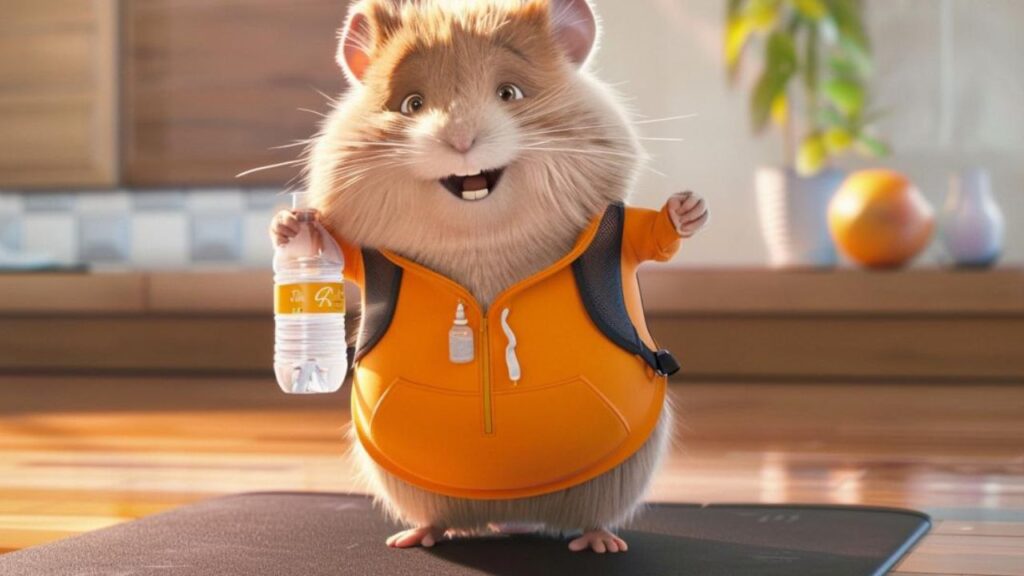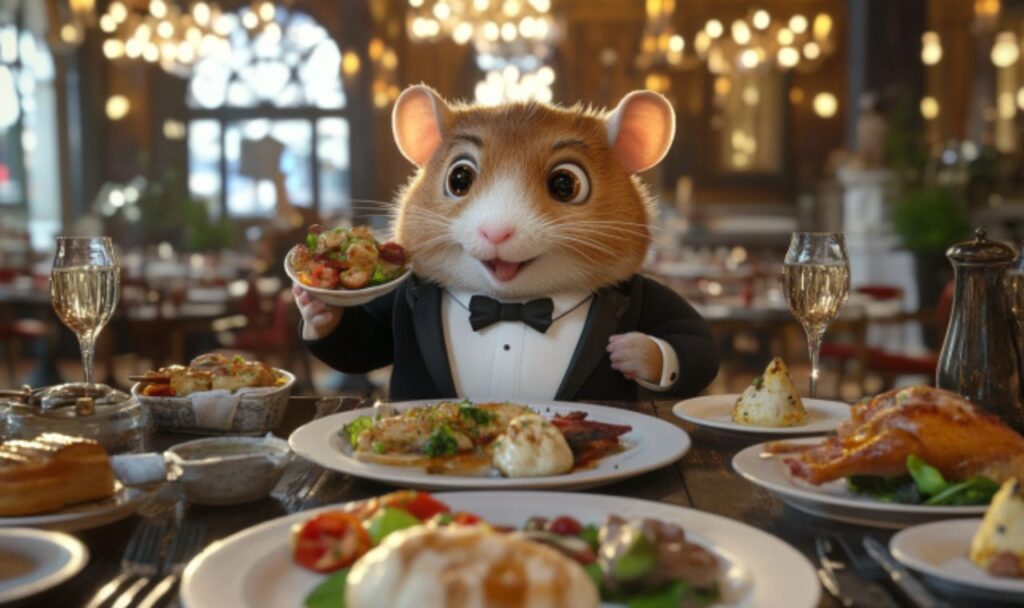Hello, fellow hamster enthusiasts! It’s Hannah Hammie here, your go-to guru for all things hamster at Hamsters.club. Today, I’m thrilled to dive into a topic that combines two of my favorite things: crafting and hamsters! We’re talking about DIY hamster toys and accessories – a fun, rewarding way to enhance your furry friend’s life while tapping into your creative side. So, grab your crafting supplies, and let’s get started!
The Joy of Crafting for Your Hamster
Creating something with your own two hands brings a unique sense of accomplishment and joy, especially when it’s for someone you love. And yes, that someone can absolutely be your hamster! Crafting for your hamster is not just about saving money or making cute Instagram-worthy accessories (though those are certainly perks); it’s about personalizing your pet’s environment, catering to their specific needs and preferences, and strengthening the bond between you and your little companion.
Understanding Hamster Play Needs
To craft the best toys and accessories, it’s important to understand what hamsters need from their play. Hamsters are curious, energetic creatures that require mental and physical stimulation to stay happy and healthy. They love to explore, climb, burrow, and chew. Any DIY project should aim to fulfill these natural behaviors, ensuring your hamster stays engaged and active.
Benefits of DIY Toys and Accessories
Besides the obvious fun factor and the opportunity to customize your hamster’s habitat, there are several benefits to DIY-ing your hamster toys and accessories. First, it allows you to ensure the safety and suitability of each item, using materials that are non-toxic and hamster-friendly. Secondly, it’s an eco-friendly option, as you can repurpose and recycle materials from around your home. Lastly, it encourages you to learn more about your hamster’s needs and behaviors, making you a more attentive and informed pet owner.
Crafting for Comfort: Cozy Hideouts
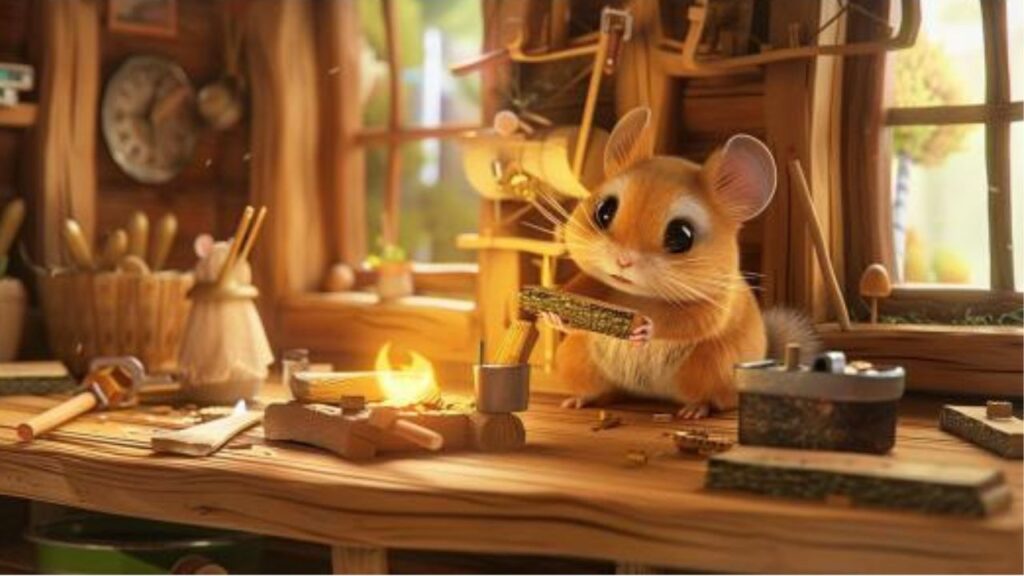
In the bustling world of a hamster, having a snug and secure place to retreat is essential. Not only do cozy hideouts offer a sense of safety, but they also provide a private spot for rest and relaxation. Let’s explore some DIY projects that will add comfort and charm to your hamster’s habitat, turning it into a haven of snugness.
Sewing a Simple Hammock
One of the simplest pleasures in life, even for a hamster, can be lounging in a hammock. Making one doesn’t require you to be a sewing wizard; you just need some basic materials and a dash of love. Here’s how:
- Materials: Choose a soft, breathable fabric like cotton or fleece. You’ll also need four sturdy strings for hanging and a needle with thread.
- Cutting: Measure and cut a rectangle out of your fabric. A size of about 8×10 inches works well for most cages.
- Sewing: Fold a tiny hem all around your rectangle to prevent fraying and sew it down. Then, securely attach a string to each corner.
- Hanging: Tie the strings to the cage’s top, adjusting the height to allow your hamster to climb in easily. Make sure it’s low enough so they won’t hurt themselves if they fall.
This hammock will not only provide a cozy lounging spot but also a new favorite playground.
Upcycling Materials for Bedding
Creating comfortable bedding for your hamster is both eco-friendly and economical. Instead of buying new materials, look around for items you can repurpose. Here are some ideas:
- Toilet paper rolls: Unbleached, unscented toilet paper is excellent for hamster bedding. Simply shred it into strips for your hamster to burrow into.
- Old T-shirts: Soft, clean, and worn cotton T-shirts can be cut into small pieces to make perfect nesting material.
- Paper bags: Non-inked, plain paper bags can be torn into strips and crumpled up for an excellent bedding base.
Ensure all materials are clean and free from chemicals before introducing them to your hamster’s home.
Creating a Hideaway from Household Items
Believe it or not, many items around your house can be transformed into perfect hamster hideaways. Here’s a simple project using a cardboard box:
- Select a Box: Choose a small, sturdy cardboard box, such as a tissue box or a small shipping box.
- Customize: Cut out one or two small doorways for your hamster to enter and exit. If you’re feeling creative, you can cut the openings in fun shapes.
- Decorate: Use non-toxic paint or markers to decorate the outside. This step is optional but can add a lovely touch to your hamster’s cage.
- Place in Cage: Put the hideaway in a quiet corner of the cage, perhaps burying part of it under bedding to mimic a burrow.
These DIY projects for creating cozy hideouts not only cater to your hamster’s need for comfort but also add a personal touch to their environment. Remember, the key is to use safe, non-toxic materials and ensure that all hideouts and bedding are easy to clean or replace. With these handmade additions, your hamster’s cage will transform into a warm and welcoming home.
Playtime Perfection: Interactive Toys
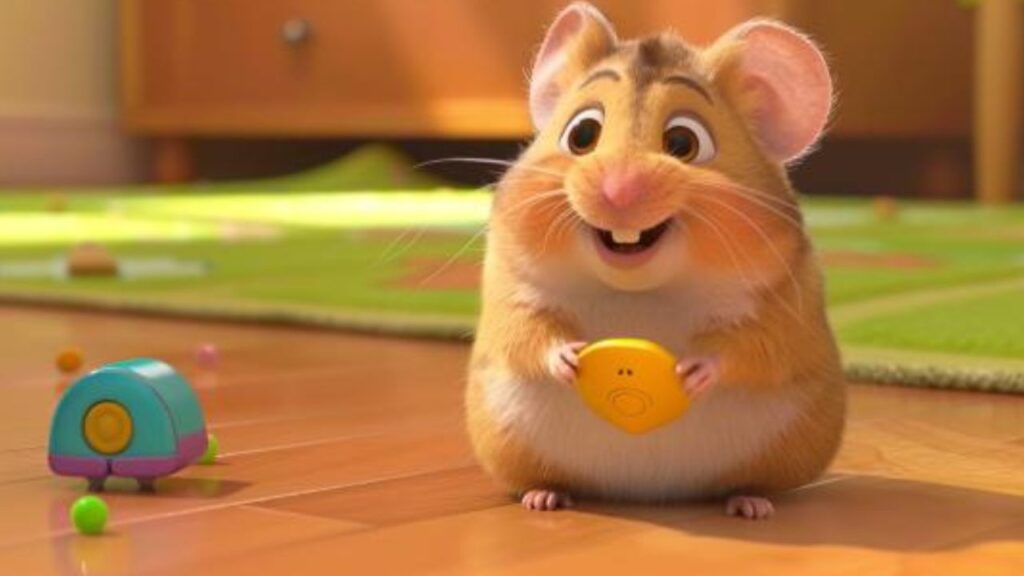
Ensuring your hamster gets plenty of playtime is crucial for their well-being. Not only does it keep them physically fit, but it also provides essential mental stimulation. Luckily, you don’t need to break the bank to offer your furry friend some exciting play options. Let’s roll up our sleeves and create a playground that promises hours of fun and discovery.
DIY Maze Adventures
Creating a maze is not only a blast for your hamster; it’s also a great way to challenge their problem-solving skills. Here’s how to build one:
- Materials: Gather some cardboard, scissors, and non-toxic glue. Old cereal boxes are perfect for this.
- Design: Plan your maze layout. It can be as simple or complex as you like, with various paths and maybe even a few dead ends to keep things interesting.
- Construction: Cut the cardboard into strips for the walls and glue them onto a base to form the pathways of your maze. Ensure the walls are high enough to prevent your hamster from climbing over.
- Extras: For added fun, hide small treats in dead ends or at the maze’s end as a reward for your hamster’s exploratory efforts.
This interactive toy not only entertains but also enriches your hamster’s daily life by encouraging natural behaviors like foraging and exploring.
Building a Hamster-safe Seesaw
A seesaw offers a fun and dynamic challenge for your hamster, promoting balance and coordination. Here’s a simple way to construct one:
- Materials: You’ll need a thin, sturdy plank (like balsa wood), a small PVC pipe, and some non-toxic glue.
- Assembly: Cut the plank to about 12 inches in length, ensuring it’s wide enough for your hamster to comfortably walk on. Cut the PVC pipe to a 2-inch length to use as the fulcrum.
- Construction: Glue the PVC pipe horizontally to the underside of the plank’s midpoint. Once dry, place the seesaw in your hamster’s play area, ensuring it’s stable and won’t tip over easily.
- Safety Check: Make sure there are no sharp edges or small parts that could harm your hamster.
This seesaw will not only provide physical exercise but also a lot of laughs for both of you as you watch their antics.
Crafting a Chew Toy Wonderland
Hamsters need to chew to keep their teeth in check, so why not turn this necessity into an adventure? Here’s a guide to creating a variety of chew toys:
- Materials: Gather untreated wood, cardboard tubes, and safe, non-toxic wooden beads or blocks.
- Design Variety: Cut the wood into different shapes and sizes. Drill holes through the pieces (if you’re handy with tools) to thread string through, creating hanging toys.
- Assembly: String wooden beads or blocks onto safe, pet-friendly twine, interspersing them with knots for added interest. Cardboard tubes can be filled with hay or treats, encouraging your hamster to chew their way through to the goodies.
- Placement: Hang or place these toys around your hamster’s cage, ensuring they are accessible but also encourage exploration and movement.
By offering a variety of textures and materials, you’ll cater to your hamster’s natural chewing instinct while keeping them engaged and entertained. Remember, the safety of materials is paramount, so always choose non-toxic, hamster-safe options.
Creating these interactive toys not only provides your hamster with endless hours of play but also strengthens the bond between you as you engage in these playful endeavors together. With a little creativity and some basic materials, you can ensure your hamster’s playtime is both fun and enriching.
Feeding Fun: Creative Food Dishes
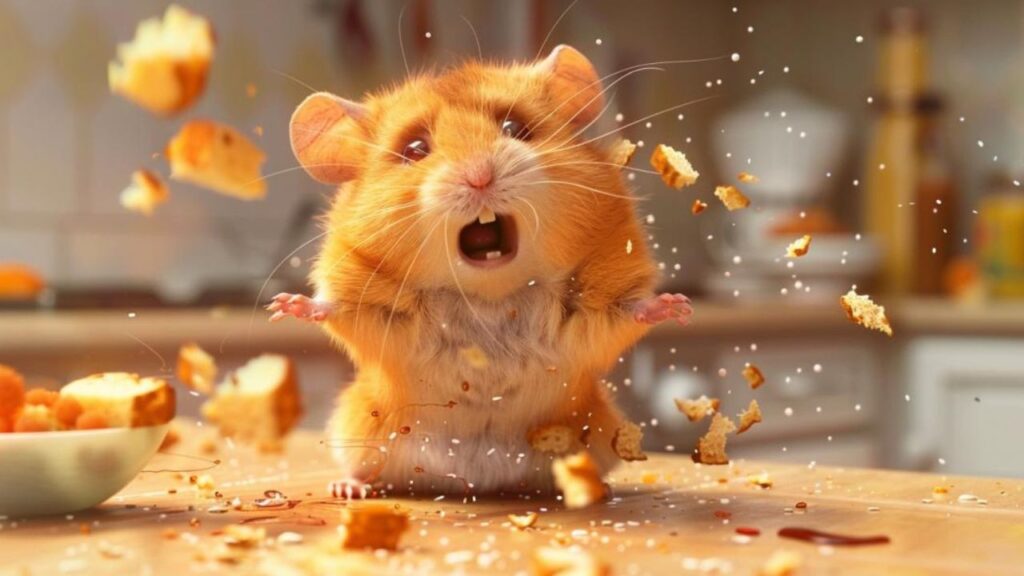
Feeding time for your hamster doesn’t have to be just another routine; it can be an exciting adventure that stimulates their mind and satisfies their belly. Let’s turn mealtime into a fun-filled experience with some creative DIY projects. These ideas will not only serve as food dishes but also as engaging activities that encourage natural foraging behaviors.
Upcycled Food Bowl Ideas
Who says you need to buy a new bowl when you can upcycle materials you already have into stylish and functional food dishes? Here’s how to get creative:
- Ceramic Teacup: An old teacup makes a charming food bowl. Ensure it’s thoroughly cleaned and the handle is removed to prevent any injuries.
- Small Jar Lids: Stainless steel or ceramic jar lids can serve as shallow dishes, perfect for serving daily meals or treats. Sand down any sharp edges for safety.
- Rock Plate: A flat, smooth stone can make a natural-looking food dish. Ensure it’s sanitized by boiling it in water for at least 30 minutes before use.
These upcycled food dishes not only add a unique touch to your hamster’s habitat but also encourage you to think sustainably.
Making a Treat Dispenser
A treat dispenser can entertain your hamster for hours while they work for their rewards. Here’s a simple way to create one:
- Materials: You’ll need a small, clean plastic bottle and a sharp tool for making holes.
- Preparation: Make small holes in the bottle—big enough for treats to fall through but small enough to keep your hamster challenged.
- Fill and Hang: Put some treats inside the bottle and hang it slightly above the ground in your hamster’s cage. They’ll have to push or nibble at the bottle to get the treats to fall out.
This DIY project not only provides mental stimulation but also encourages physical activity as your hamster works to obtain their treats.
DIY Foraging Toys for Mealtime Excitement
Turning mealtime into a foraging game mimics your hamster’s natural feeding behaviors and provides mental stimulation. Here’s how to create a simple foraging toy:
- Materials: Gather small cardboard boxes, paper bags, or toilet paper rolls.
- Preparation: Cut small holes in your chosen material, slightly larger than the size of your hamster’s food pellets or treats.
- Fill and Hide: Place the hamster’s food inside the box, bag, or roll and then hide it in their cage, encouraging them to sniff and search for their food.
These DIY foraging toys make eating a more engaging and rewarding experience for your hamster, stimulating their instinct to search and work for their food.
Incorporating these creative feeding methods not only enhances your hamster’s daily routine but also contributes to their overall well-being by keeping them physically and mentally active. Plus, it’s a delightful way to observe their cleverness and agility in action. Remember, the goal is to make feeding time as enriching and enjoyable as possible, fostering a happy and healthy life for your furry friend.
Exercise Essentials: Keeping Your Hamster Active
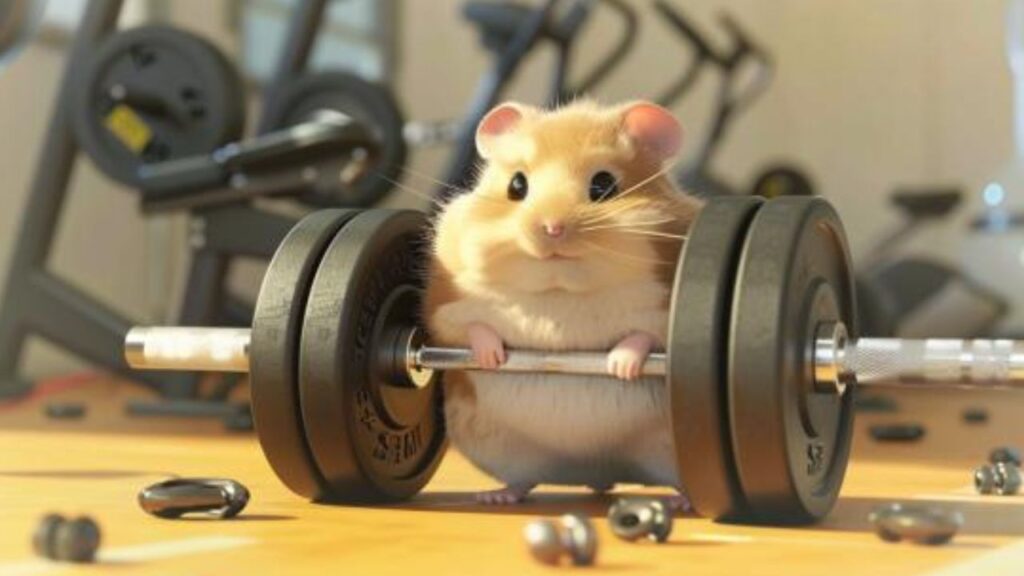
Keeping your hamster active is crucial for their physical and mental health, preventing boredom and promoting a healthy lifestyle. Fortunately, encouraging exercise doesn’t have to involve expensive equipment. With a bit of creativity and some household items, you can construct fun, engaging exercise accessories. Let’s delve into how you can create a cardboard wheel, design an obstacle course, and make homemade tunnels for endless exploration.
Constructing a Cardboard Wheel
A running wheel is an essential item in any hamster’s habitat, providing a great source of exercise. Here’s how to DIY a safe and sturdy cardboard wheel:
- Materials: You’ll need thick cardboard, non-toxic glue, a skewer or a smooth, straight stick, and a sturdy base (like a larger piece of wood or a heavy cardboard base).
- Wheel Construction: Cut out two large circles from your cardboard for the wheel’s sides. Then, cut a strip of cardboard long enough to wrap around the edge of your circles, creating the wheel’s running track. Glue the strip evenly between the two circles, ensuring there are no gaps.
- Mounting: Use the skewer or stick as the axle. It should be longer than the wheel’s diameter. Secure it through the center of your wheel and attach it to your base, ensuring the wheel spins freely and is stable.
- Safety Check: Make sure the wheel is smooth with no sharp edges and is large enough for your hamster to run without arching its back.
Designing an Obstacle Course
An obstacle course is a fantastic way to enrich your hamster’s environment and provide a fun exercise challenge. Here’s how to set one up:
- Plan Your Design: Sketch a layout that includes various sections, like ramps, bridges, tunnels, and platforms. Ensure it’s appropriate for your hamster’s size and abilities.
- Gather Materials: Use items like cardboard for barriers, tubes for tunnels, and small boxes or blocks for steps and platforms. Everything should be hamster-safe and non-toxic.
- Assembly: Arrange your obstacles in a challenging yet navigable way within a secure area or your hamster’s playpen. Introduce variety by changing the course layout regularly.
- Supervision: Always supervise your hamster during playtime to ensure they’re safe and not chewing on anything harmful.
Homemade Tunnels for Exploration
Tunnels mimic the burrows hamsters would naturally create in the wild, providing both exercise and a sense of security. Here’s a simple method for making them:
- Materials: Cardboard tubes (from paper towels, toilet paper, or wrapping paper), non-toxic glue, and scissors.
- Construction: Cut the tubes into various lengths. You can even split some lengthwise to create half-tunnels. Use non-toxic glue to connect the pieces, forming an extensive network of tunnels.
- Customization: Create branches, intersections, and hidden chambers to make the tunnel system more interesting. Ensure the tunnels are wide enough for your hamster to pass through comfortably.
- Placement: Place the tunnel system in your hamster’s enclosure or play area, partially burying some sections under bedding to increase the challenge and appeal.
By creating these exercise essentials, you not only provide your hamster with a stimulating environment but also contribute to their overall health and happiness. Watching your furry friend navigate the obstacle course, run on their cardboard wheel, or explore the homemade tunnels offers endless entertainment and reinforces the bond between you. Remember, the key to a happy hamster is variety and safety, so always monitor their playtime and regularly introduce new activities.
Hannah’s Training Tactics

Introducing new toys and activities to your hamster’s environment is crucial for their wellbeing, providing both mental stimulation and physical exercise. However, doing so requires a thoughtful approach to ensure they are both interested and safe. Here’s my guidance on introducing new toys, observing your hamster’s preferences, and conducting safety checks for DIY toys. These tactics are aimed at enriching your hamster’s life while keeping their safety at the forefront.
Tips for Introducing New Toys
- Go Slow: Introduce new toys one at a time to avoid overwhelming your hamster. Allow them to explore and become familiar with each item at their own pace.
- Placement: Place new toys near areas your hamster frequents or shows interest in. This increases the likelihood of interaction.
- Encouragement: Sometimes, a little encouragement goes a long way. Place treats near or on the new toy to pique your hamster’s curiosity and reward their exploration.
- Monitor: Watch how your hamster interacts with the new toy. Ensure they are using it as intended and not in a way that could lead to injury.
Observing Your Hamster’s Preferences
Understanding what your hamster enjoys most will help you create a more engaging and satisfying environment for them. Here are some tips:
- Variety: Offer a wide range of toys and activities to discover what interests your hamster the most, whether it’s climbing, burrowing, chewing, or running.
- Engagement: Notice which toys your hamster spends the most time with. High engagement is a clear indicator of their preferences.
- Behavior: Pay attention to your hamster’s behavior. Contentment signs include active exploration, using toys as intended, and displaying natural behaviors like foraging and nesting.
- Adjustments: Be willing to remove toys that don’t spark interest or replace them with variations to see if a slight change might make them more appealing.
Safety Checks for DIY Toys
Ensuring the safety of DIY toys is paramount. Before introducing any new item to your hamster’s cage, conduct these checks:
- Materials: Confirm all materials are non-toxic and safe for hamsters. Avoid anything painted, treated with chemicals, or small enough to be ingested.
- Sturdiness: Make sure the toy is sturdy and won’t collapse or break under your hamster’s weight, potentially causing injury.
- Edges: Inspect for sharp edges or points that could harm your hamster. Sand down or cover any risky areas.
- Size: Ensure openings in tunnels or hideouts are large enough for your hamster to pass through comfortably without getting stuck.
- Maintenance: Regularly inspect toys for signs of wear and tear. Remove any damaged toys from the cage to prevent risks of injury or ingestion of small parts.
Conclusion
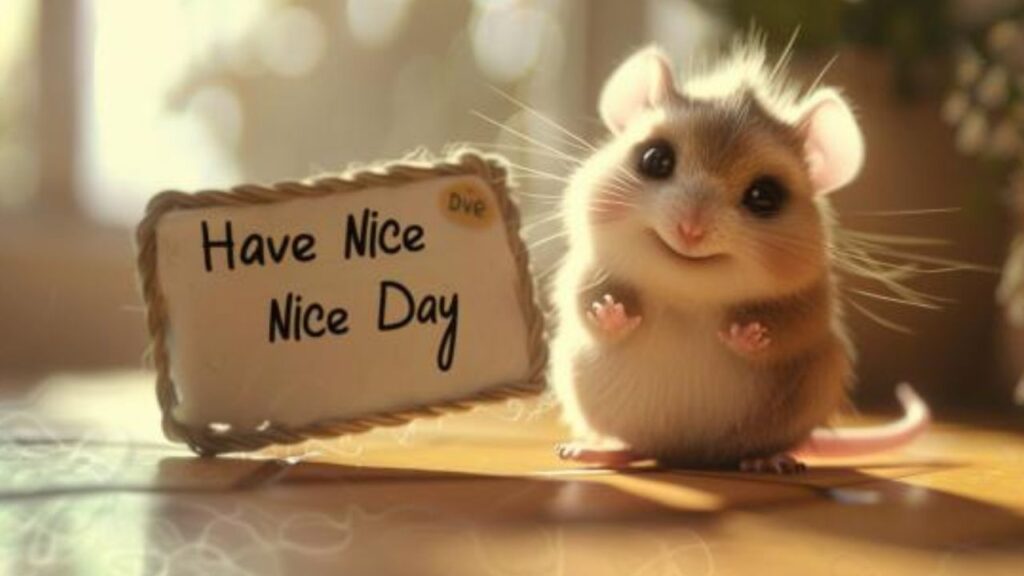
As we wrap up our crafting journey through the world of DIY hamster toys and accessories, it’s clear that the benefits and joys of creating a personalized and engaging environment for our furry friends are manifold. From cozy hideouts and interactive toys to creative feeding dishes and essential exercise equipment, the possibilities to enhance your hamster’s life are virtually endless. Each project not only promises to keep your hamster entertained and active but also strengthens the bond between you and your pet, offering a unique insight into their preferences and behaviors.
The act of DIY for your hamster is more than just a hobby; it’s a demonstration of love and care. It allows you to ensure the safety, suitability, and fun factor of your hamster’s accessories, all while being mindful of the environment by repurposing and recycling materials. Moreover, these projects encourage you to engage with your hamster’s needs on a deeper level, fostering a greater understanding of these delightful creatures.
I wholeheartedly encourage you to try your hand at making at least one toy or accessory for your hamster. Whether it’s a simple chew toy wonderland, a cardboard maze, or a cozy hammock, the satisfaction of watching your hamster explore and enjoy something you’ve made with love is unparalleled. Start with something straightforward, and who knows? You might discover a hidden talent or develop a new passion for hamster-centric crafts.
I invite you, the amazing community of hamster enthusiasts, to share your creations and experiences. Whether it’s through photos, videos, or stories, let’s celebrate our efforts to make our hamsters’ lives as joyful and enriching as possible. Your shared experiences can inspire and encourage others to embark on their DIY journey, spreading the joy of crafting far and wide within our community.
Remember, every stitch, cut, and dab of glue brings you closer to understanding and providing for your hamster’s needs. So, I encourage you to embrace the creative process, experiment with new ideas, and above all, enjoy the time spent enhancing your hamster’s world. With paws and patience, you’re not just crafting toys; you’re crafting happiness.
I look forward to seeing your innovative designs and hearing about your hamster’s reactions. Together, we’re not just hamster owners; we’re Hamster Whisperers, dedicated to creating a stimulating and love-filled environment for our pets. Happy crafting, and may your hamster’s cage be a testament to your creativity and care!
With paws and patience, you’re on the road to being a Hamster Whisperer. Happy training!



